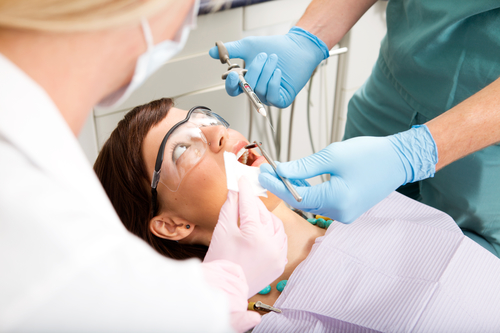
While you were in for a routine cleaning last week, the dentist discovered a cavity. Whoops! With the help of the digital X-rays taken at the start of your cleaning, the dentist identified the cavity in one of the back molars on your lower jaw. He then explained how it would be fixed when you returned to the office the following week. “Stop by the front desk on your way out and schedule an appointment for a filling next week. We’ll need about 45 minutes.”
You returned for your filling this morning. The dentist administered an injection of novocaine to freeze or numb the nerves in your molar with the cavity and the area surrounding it. Everything went well, but that was HOURS ago! Why does it take such a long time for dental freezing to wear off when you get a filling in a tooth on your lower jaw?
First of all, if you’re a little nervous because your procedure was hours ago and you’re still frozen, don’t be. The way people process anesthetic is different for everyone, and this can be quite normal. Depending on the type of anesthetic used, the dental freezing may last one to two hours or up to six to eight hours. As long as there is some improvement as time passes, there is nothing to worry about.
What is dental freezing?
Another term for anesthetic is freezing. It is “medication that produces the temporary loss of feeling or sensation.”
There are two types of anesthetic:
- topical anesthetic – used to numb the surface of your mouth where the injection will be administered
- local anesthetic – a solution injected near a nerve in your mouth to numb your teeth and its surrounding area. It blocks nerves from generating an impulse.
Why does dental freezing take longer to freeze and unfreeze the lower jaw or jawbone?
It takes longer to freeze because the bone is dense. Because the bone is dense, your dentist performs a block injection. Compared to dental freezing done on upper teeth which freezes only one or two teeth, a lower nerve block freezes all the teeth in the lower quadrant of your jaw. This dental freezing procedure freezes approximately half of your mouth. You will most likely feel numbness to your cheek, lip, chin and tongue.
Techy facts from Wiki: “An injection blocks sensation in the inferior alveolar nerve, which runs from the angle of the mandible (jawbone) down the medial aspect of the mandible, innervating the mandibular teeth, lower lip, chin, and parts of the tongue, which is effective for dental work in the mandibular arch. To anesthetize this nerve, the needle is inserted somewhat posterior to the most distal mandibular molar on one side of the mouth. The lingual nerve is also anesthetized through diffusion of the agent to produce a numb tongue as well as anesthetizing the floor of the mouth tissue, including that around the tongue side or lingual of the teeth.” Wow! Do not try this at home!
How long does freezing last?
Remember, the way people process anesthetic is different for everyone, and the freezing will go away completely at different rates, depending on the type of anesthetic used. According to the Canadian Dental Association, the approximate duration of anesthetic is as shown:
|
Type of Anesthetic |
Maxillary |
Mandibular |
|
Articaine 4% with epinephrine |
3 hours 10 min |
3 hours 50 minutes |
|
Bupivacaine 0.5% with epinephrine |
5 hours 40 min |
7 hours 30 minutes |
|
*Lidocaine 2% with epinephrine |
2 hours |
3 hours 10 minutes |
|
Mepivacaine 2% with levonordefrin |
2 hour 10 min |
3 hours 5 minutes |
|
Mepivacaine 3% plain |
1 hour 30 min |
2 hours 45 minutes |
|
Prilocaine 4% with epinephrine |
2 hours 20 min |
3 hours 40 minutes |
| *Prilocaine 4% plain | 1 hour 45 min |
3 hours 10 minutes |
* Used in our dental practice.
Are there complications associated with dental freezing?
Be aware that complications can occur. While rare, it is important to tell your dentist of any medications you are taking or medical procedures you have had. If you have any questions or concerns about possible complications associated with dental freezing, please ask.
The most common complications are biting your lip, cheek or tongue while they are frozen and without sensation. It is possible to bite the inside of your mouth rather severely while there is no feeling. This is why we strongly suggest that you do not chew gum or eat foods that require chewing. We recommend soups, puddings, yogurts, mashed potatoes, etc. be eaten instead.
Cavities, dental freezing and fillings go hand in hand. You can’t have one without the other. If you need peace of mind about this common dental procedure, we can help. Call Sherwood Dental at (780) 464-4166 and ask the questions you may have regarding dental freezing! Really, we would love to answer every one.



